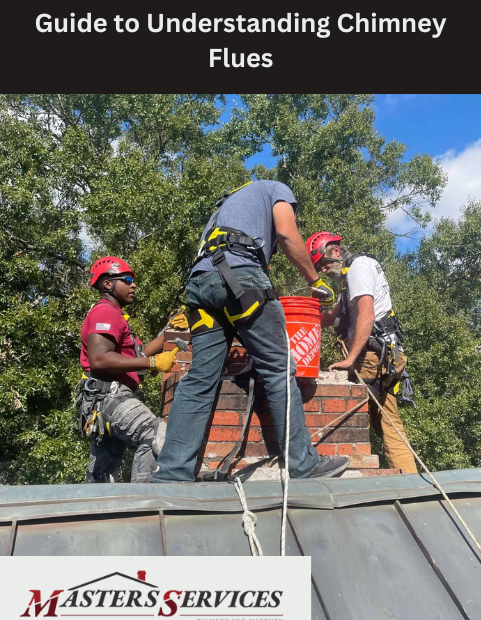Guide to Understanding Chimney Flues
Understanding chimney flues is crucial for knowing how to maintain and operate your chimney system. Chimney flues allow smoke and gases to exit, preventing indoor fume buildup. Components like the flue liner and chimney cap play key roles in ventilation. Flues work by regulating airflow and insulating against cold air. Regular maintenance, including inspections and cleaning, is vital to prevent chimney fires. Neglecting maintenance can lead to serious issues. Remember, a well-maintained flue ensures proper ventilation and extends the lifespan of your chimney and fireplace. Explore the components and workings further to keep your system safe and efficient.
What Is a Chimney Flue?
Chimney flues are the passageways that allow smoke and gases to safely exit your fireplace or stove. These essential components ensure that the byproducts of combustion are directed outside, preventing the buildup of dangerous fumes inside your home. A well-maintained chimney flue is crucial for the efficient operation of your fireplace or stove, as it promotes proper ventilation and prevents the risk of carbon monoxide poisoning.
The size and construction of chimney flues vary depending on the type of heating appliance they’re connected to. It’s important to regularly inspect and clean your chimney flue to remove any obstructions that could impede the flow of smoke and gases. Creosote buildup, debris, or even animal nests can block the flue, increasing the risk of chimney fires or smoke backing up into your home. Understanding the purpose and function of chimney flues is essential for ensuring the safety and effectiveness of your heating system. By maintaining your chimney flue properly, you can enjoy a cozy fire without compromising your well-being.
Components of a Chimney Flue
To understand the functionality of chimney flues fully, it’s important to recognize the various components that make up these crucial passageways. Here are the key elements that constitute a chimney flue:
1. Flue Liner: This protective layer inside the chimney directs smoke and gases safely outside while preventing heat transfer to combustible materials.
2. Smoke Chamber: Located just above the fireplace, this area helps to compress and direct smoke up into the flue.
3. Chimney Cap: Positioned atop the chimney, this cap keeps out rain, snow, debris, and animals while also preventing downdrafts.
4. Chimney Crown: Serving as the roof of the chimney, this component helps shed water away from the flue, protecting it from moisture damage.
Understanding these components will give you a clearer picture of how a chimney flue functions and the importance of each part in maintaining a safe and efficient chimney system.
How Chimney Flues Work
Understanding the mechanics behind chimney flues helps illuminate the vital role they play in maintaining a properly functioning and efficient fireplace system.
Chimney flues work by creating a passage for smoke, gases, and other byproducts of combustion to safely exit your home. When you light a fire, the hot air and smoke rise through the flue due to the temperature differential between the inside of the flue and the outside air. This process is known as draft, and it’s crucial for ensuring that harmful fumes don’t enter your living space.
The flue also helps to regulate airflow, preventing downdrafts that can push smoke back into your home. Additionally, chimney flues insulate against the cold outdoor air, which helps to maintain the temperature inside the flue, further aiding the upward flow of smoke.
Importance of Chimney Flue Maintenance
Regular maintenance of your chimney flue is crucial for ensuring the safety and efficiency of your fireplace system. Neglecting chimney flue maintenance can lead to serious issues such as expensive chimney repairs, chimney fires, carbon monoxide leaks, and poor ventilation. To emphasize the importance of chimney flue maintenance, consider the following:
1. Safety First: By regularly having your chimney flue inspected and cleaned by a professional and educated chimney company, you can prevent dangerous chimney fires.
2. Efficiency Matters: A clean and well-maintained chimney flue allows for better airflow, which improves the efficiency of your fireplace and helps reduce energy costs.
3. Health Concerns: Proper maintenance of the chimney flue helps prevent the buildup of harmful gases like carbon monoxide, safeguarding the health of your household.
4. Longevity of Your System: Regular maintenance extends the lifespan of your chimney and fireplace, saving you money on costly repairs or replacements in the long run.
Key Takeaways
- Flue liners direct smoke safely to the outside. –
- Smoke chambers compress and guide smoke upwards.
- Chimney caps protect against weather and animals.
- Chimney crowns divert water away from the flue.
- Understanding components aids in proper maintenance.
Professional Chimney Sweep & Repair Service in Dallas, Fort Worth, Houston & Oklahoma City
Masters Services Chimney & Masonry is your trusted partner for chimney and masonry services in the Dallas-Fort Worth Metroplex, Houston, Oklahoma City, and neighboring areas. Our expertise ensures comprehensive solutions for your chimney needs. Through this blog, we aim to empower homeowners with knowledge to make informed decisions regarding chimney maintenance. Overall, understanding chimney flues is crucial for the proper functioning of your fireplace and ensuring the safety of your home. By knowing what a chimney flue is, how it works, and the importance of regular maintenance, you can prevent potential hazards and keep your chimney in top condition. Remember to schedule regular inspections and cleanings to keep your chimney flue working efficiently and correctly.
